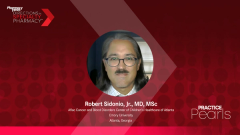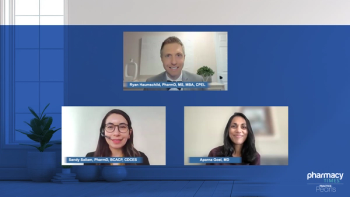
Overcoming Barriers in Specialty Pharmacy for Treatment of Hemophilia A
Key opinion leaders discuss how specialty pharmacies can work collaboratively to overcome both financial and nonfinancial barriers in hemophilia A.
Episodes in this series

Jonathan Ogurchak, PharmD, CSP: We’ve been talking a lot about the financial barriers and some of these nonfinancial barriers as well. I’d kind of like to open this up to the panel for everybody to weigh in a little bit. How, in your work with those specialty pharmacies directly, how have you seen the partnership there to help to overcome some of those financial and nonfinancial barriers? I’m not sure who wants to jump in and start.
Robert Sidonio, Jr., MD, MSc: I can.
Jonathan Ogurchak, PharmD, CSP: Start with it.
Robert Sidonio, Jr., MD, MSc: I can start out. Like I mentioned before, and Dr. Abramson did a nice discussion about the role of the specialty pharmacy already, but ours is separate. Every center is different, so they need to figure out what’s the ideal situation and the ideal collaboration. At our center, the specialty pharmacy is not associated with us. They’re separate. They’re within the same city and we work with them, of course, so we actually have pretty routine meetings. Actually, they’re involved because they’re part of the community as well, specifically concerning community advocacy, and so really, our social worker is a really big part of this. The social worker tries to help uncover some of those things that you don’t know about such as what’s going on, if there’s an impending divorce going on, if there’s other issues at home, child is not doing very well, maybe they’re having shifting who is going to be in charge with custody. Thus, it really starts with that, because if you don’t know any of those situations, just prescribing the drug and sending somebody out to do it is just not going to be successful. Hence, we really try to work with them. We try to work with the different companies, try to understand what insurance they have, try to find out what the barriers are, and try to shift patients into insurance plans that are going to work. We always tell them they can’t have catastrophic insurance plans that only pay for if there’s something terrible that happens. We really try to help them understand that you have to have a plan that’s going to work, one that’s going to allow us to see them as well because some models don’t allow them. They’ll say, “We’re out of network,” and obviously that’s going to put a big financial burden because they can’t go see a non-hemophilia doctor. It’s really a team effort. We have the collaborative, comprehensive care model, and we try to make sure we reach out with them. We actually have recurring meetings with our different specialty pharmacies to try to determine what’s going on, follow up on those prescriptions, like are they actually getting them? Are they actually using them? Are patients stockpiling factor and not actually doing it? We are really trying to understand, because the end point is making sure the factor gets into that child or nonfactor and that he/she has no bleeding issues, because we’ve had some where there’s been issues at home and the child comes in with a life-threatening bleeding event and we didn’t realize that he/she is not getting factor because of what’s going on. There’s an aunt that’s sick and so he/she couldn’t, Mom wasn’t there, and she couldn’t administer it. We are really trying to understand all of the social issues because they play a huge role, and really trying to make sure that we get to deliver the care that we want to deliver because obviously that’s important and figure out the financial stuff on the back end.
Jonathan Ogurchak, PharmD, CSP: If there is anyone else, let’s talk a little bit maybe about working with payers as it relates to the affordability piece of things. I know you talked a little bit about looking to align appropriate payers just based on catastrophic coverage and things like that, but there’s other resources that may be available as it relates to copay or compassionate use types of product offerings. Let’s talk about that for a couple minutes. How, in working with specialty pharmacies, can they jump in and really help to mitigate some of those concerns for patients and their families when they’re working to establish a regimen there? Dr. Kuhn, I don’t know. I’ll pick on you here. You have any thoughts on that relationship?
Alexis Kuhn, PharmD, BCOP: Yes. I’m probably going to pass it off to Dr. Abramson with her experience over with AllianceRx, but really certainly knowing what options are available based off of the agent that you are choosing and the insurance, what agents the insurance is willing to cover, knowing if there are copay assistance options through the manufacturers. Thus, really being able to identify those opportunities and if it does require these burdensome forms, assisting the families in filling out the form can be monumental. I can’t tell you how many times I’ve encountered situations where we can take something covered, but it’s going to take an arm and a leg filling out all these forms, and sometimes that’s just too much for families to do. If you can provide assistance and really sit down, and this I’ll reiterate what Dr. Sidonio kind of highlighted which is the point of social workers who are amazing and we cannot herald their benefit enough in helping to fill out some of these paperwork that is necessary, and ultimately will benefit the families in the long run, but may be burdensome upfront. I think just being able to know what options you have and then actually being able to facilitate filling out those forms.
Robert Sidonio, Jr., MD, MSc: Those factor assistance programs are really critical, and sometimes they bridge the patients between insurance when there’s gaps in coverage, switching jobs, having to do different things, and so they’re really helpful. Sometimes, we often let the specialty pharmacies hold that drug, when they have those free factor programs, and whether you are interested in them, so we often will utilize those, particularly in those difficult situations, and if they’re bridging from clinical trial to needing the factor prescribed. Thus, there’s a lot of resources from the different companies and they often come out and tell us what those resources are. There are limitations, obviously, but oftentimes we can figure out ways to make sure there are not gaps in coverage and not gaps in treatment for the patients. I’ll let Dr. Abramson comment more. I know she has a lot of experience with this, navigating this difficulty.
Anastasia Abramson, PharmD, MBA: No, you’ve both covered it really well. Our specialty pharmacy has a team that helps to facilitate the patient financial services and get them set up with copay assistance. I did mention that most of the patients that we see, their insurances do cover the product, but then the question becomes what the actual out-of-pocket patient responsibility is, which can be pretty high, pretty impactful, and an impediment. Thus, it’s really listening to the patient and where he/she is expressing those concerns for access and affordability is finding them the program that can suit them. And then, as Dr. Kuhn mentioned, helping them with the paperwork and doing whatever is needed on our end in terms of the forms and submitting on his/her behalf or the provider’s behalf wherever we can.
Jonathan Ogurchak, PharmD, CSP: No, that’s a point well taken by all of you. When you’re looking at these patients, particularly immediately upon diagnosis, not only are they grappling with the diagnosis itself and trying to understand how to live with this new challenge that is faced there, but then to have to worry about the financial piece of things and trying to piece that all together. Sometimes that just becomes a burden that’s too great to bear and it’s really a great place for those specialty pharmacies to step in, having that expertise to know how to juggle the ins and outs of the payers, the ins and outs of the programs. Let folks like Dr. Sidonio focus on diagnosis and appropriate use and Dr. Kuhn help to manage and get people started and really help to build that collaborative care model so that way everybody has a place in taking care of those patients and supporting the families moving forward.
Transcript edited for clarity.
Newsletter
Stay informed on drug updates, treatment guidelines, and pharmacy practice trends—subscribe to Pharmacy Times for weekly clinical insights.













































































































































































































